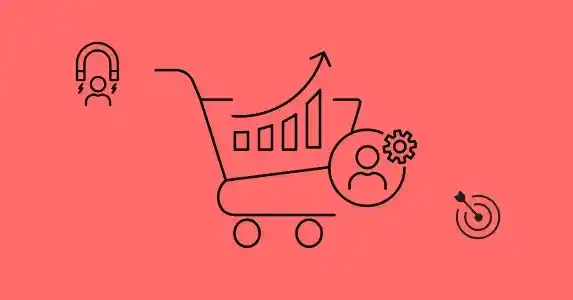Let’s be real—shopping behavior has fundamentally changed, and that’s exactly why so many marketers are asking, what is omnichannel retail and why does it matter now more than ever?
Today’s customers jump between channels like pros. They discover products on Instagram, compare prices on Google, add to cart via mobile, complete the purchase on desktop, and maybe even return it in-store. They’re not thinking in terms of “online” or “offline.” They’re just shopping.
If you’re leading ecommerce, retention, or marketing, you already know how disjointed customer journeys can hurt conversions. Omnichannel retail solves that by making the brand experience fluid, not fragmented.
And in 2025, that fluidity isn’t just a nice-to-have—it’s a deal breaker.
What Is Omnichannel Retail?
Omnichannel retail means integrating all your customer touchpoints—website, app, physical stores, social media, customer service, email, SMS, and more—into one cohesive experience. Customers can transition smoothly between them without losing context or continuity.
According to our survey, omnichannel shoppers now represent one in three shopping journeys, as per McKinsey.
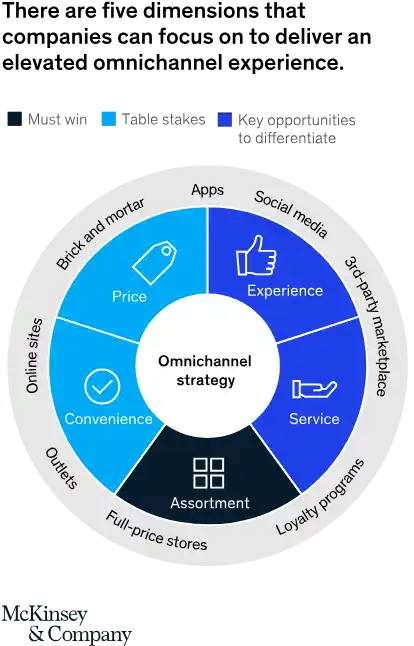
Breaking it down:
- It’s not just about having multiple channels (that’s multichannel).
- It’s about connecting those channels so customers don’t have to start over.
- It’s about using data intelligently to personalize every interaction.
When done right, customers feel like your brand knows them—whether they’re chatting with a bot, talking to a store rep, or opening an email.
A Quick Comparison
| Feature | Multichannel | Omnichannel |
|---|---|---|
| Channels used | Many (separately) | Many (connected) |
| Customer data sharing | Isolated | Unified |
| Personalization consistency | Low | High |
| Shopping experience | Fragmented | Seamless and integrated |
Why a Seamless, Integrated Experience Is Non-Negotiable
Disconnected channels create friction. Integrated experiences create confidence, trust, and higher lifetime value.
Imagine a customer adds shoes to their cart on your app. Later, they walk into your store and get asked, “How can I help you today?”—with no knowledge of their preferences, past orders, or intent. That’s a missed opportunity.
Why it matters:
- 73% of shoppers use multiple channels during their purchase journey.
- Customers are 3x more likely to complete purchases when experiences feel connected.
- Consistency drives better engagement, retention, and brand recall.
What it takes:
- Unified data: Centralized insights from all touchpoints
- Real-time sync: Channels must communicate instantly
- Brand alignment: Same tone, messaging, pricing, and experience across every touchpoint
Disconnected journeys cause friction. Friction causes churn. Omnichannel removes the friction.
Benefits of Omnichannel Retail for Ecommerce Leaders
A strong omnichannel strategy boosts engagement, sales, and brand perception—all while lowering your acquisition costs and operational complexity.
Here’s what you stand to gain:
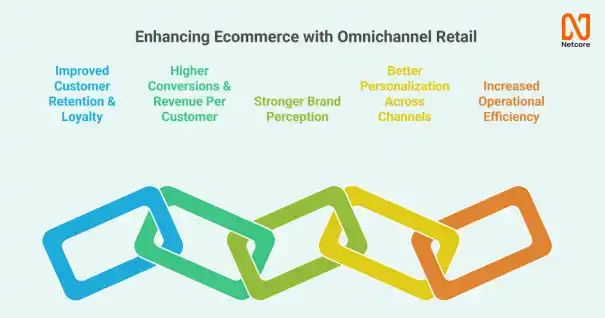
1. Improved Customer Retention & Loyalty
- Customers love familiarity. Seeing a consistent brand experience across channels builds trust.
- Personalization based on past purchases or browsing history keeps shoppers coming back.
2. Higher Conversions & Revenue Per Customer
- Follow up on app carts via email or SMS.
- Offer personalized discounts based on in-store visits.
- Contextual engagement = better timing = higher sales.
3. Stronger Brand Perception
- Cohesive brand design, tone, and messaging build recognition.
- Whether in-store or online, customers see one unified brand identity.
4. Better Personalization Across Channels
- Send emails that reflect app behavior.
- Customize in-store recommendations using online data.
- Target customers based on lifecycle stage, not just channel behavior.
5. Increased Operational Efficiency
- Shared inventory visibility reduces lost sales.
- Fewer customer complaints thanks to synced data.
- Easier attribution and smarter decision-making across departments.
When you connect the dots, both your customer and your bottom line win.
Real-World Examples of Omnichannel Retail in Action
Top retailers create connected experiences that follow the customer—not the channel.
Let’s look at some brands doing omnichannel right:
Sephora
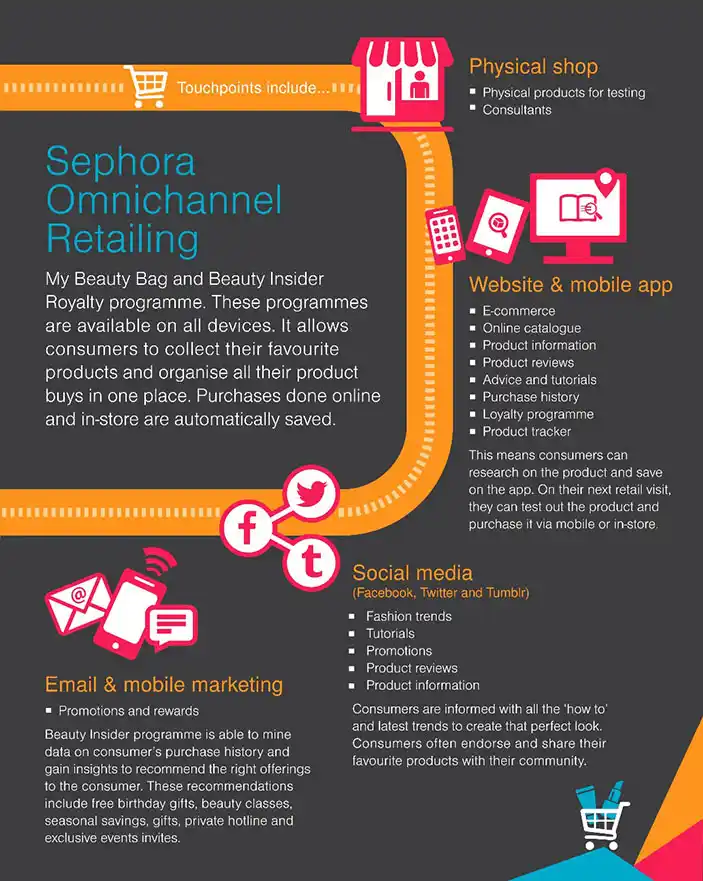
- Offers virtual try-ons through its app and mirrors them in-store.
- Customer profiles sync purchases and preferences across all platforms.
- Sends personalized reminders about products browsed in-store but not purchased.
Source: nGrow
Nike
- Lets app users scan and buy in-store without waiting at the register.
- Rewards and memberships work the same whether online or in-store.
- Consistent branding and promotions across app, email, and social.
Tata CLiQ (India)
- Unified cart that works on app, desktop, or physical kiosks.
- Localized offers based on customer’s region and store availability.
- Post-purchase tracking is unified across all touchpoints.
Decathlon
- Store staff use digital tools to access online wishlists.
- Customers receive personalized product suggestions based on store visits and browsing history.
- In-store QR scanning connects offline intent with online retargeting.
Each of these brands invests in one thing: making the customer journey feel like one story, no matter where it happens.
Key Pillars of a Successful Omnichannel Retail Strategy
The secret to omnichannel success lies in unified data, intelligent systems, consistent experiences, and real-time adaptability.
1. Customer Data Unification
- Use a Customer Data Platform (CDP) to consolidate identities.
- Integrate CRM, POS, website analytics, app events, and loyalty platforms.
- Ensure data is accessible and actionable in real time.
2. Channel Integration
- Sync inventory across ecommerce and physical stores.
- Ensure orders, returns, and loyalty redemptions are visible everywhere.
- Connect marketing platforms with commerce platforms.
3. Personalization & Targeting
- Use AI to identify behavior patterns, affinities, and propensities.
- Automate lifecycle journeys—onboarding, abandonments, reactivations.
- Adjust messaging based on real-time behavior.
4. Consistent Experience Across Channels
- Match product recommendations, pricing, and availability.
- Ensure emails, web banners, WhatsApp messages, and app promos align.
- Train teams across functions to maintain brand tone and voice.
5. Cross-Channel Measurement & Optimization
- Move beyond last-click attribution.
- Analyze what touchpoints drive purchase intent and retention.
- Use insights to optimize messaging and budget allocation.
You can’t personalize what you can’t unify—and you can’t optimize what you can’t measure.
How to Build Your Omnichannel Retail Strategy
You don’t need to overhaul your stack overnight. Start small. Prioritize high-impact customer journeys. Then scale omnichannel retail solutions.
Follow this roadmap:
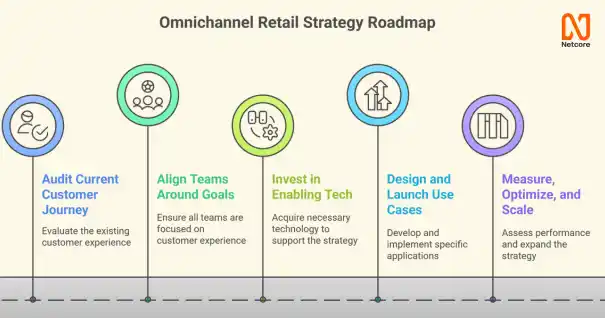
- Audit your current customer journey
- Identify where transitions break (e.g. app to store, cart to email)
- Understand how data flows—or doesn’t—between platforms
- Align teams around customer experience goals
- Set shared success metrics like NPS, CLTV, and engagement rate
- Bring marketing, tech, and operations to the same table
- Invest in the right enabling tech
- Choose a flexible CDP or CRM platform
- Ensure your marketing automation tools are API-ready
- Integrate your ecommerce backend with POS and analytics
- Design and launch use cases
- Example: cart abandonment triggered via email and WhatsApp
- Example: loyalty points earned online and redeemed in-store
- Example: retargeting app users based on in-store visits
- Measure, optimize, and scale
- Use insights to improve targeting and reduce churn
- Don’t chase every trend—double down on what works
- Continue aligning messaging as new channels emerge
Start with one channel transition. Nail it. Then move to the next. Omnichannel is a marathon, not a sprint.
Common Challenges & How to Overcome Them
Yes, omnichannel retail marketing is complex—but avoidable pitfalls exist, and they’re fixable with the right mindset and systems.
The usual suspects:
Data Silos
- Solution: Use middleware or CDP to centralize data in real-time.
Team Silos
- Solution: Incentivize collaboration with shared KPIs.
Channel-Specific Metrics
- Solution: Focus on full-funnel metrics—like CLTV and blended ROAS.
Legacy Systems That Don’t Talk
- Solution: Pick modular, API-first platforms that plug and play.
Tool Overload
- Solution: Consolidate tools based on business impact, not vanity features.
Final Take
Your customers won’t wait for your systems to catch up. They already expect brands to “remember” them across every interaction.
So here’s the thing: omnichannel isn’t about being on every channel. It’s about connecting the ones that matter most to your customers—and doing it in a way that feels intuitive, helpful, and consistent.
If you can meet your customer where they are and make that moment feel effortless? That’s when the magic (and the margin) happens.
 Holiday Sales Are Won Now — Grab the 2025 Holiday Marketing Guide to Unlock More Revenue.
Holiday Sales Are Won Now — Grab the 2025 Holiday Marketing Guide to Unlock More Revenue. 










